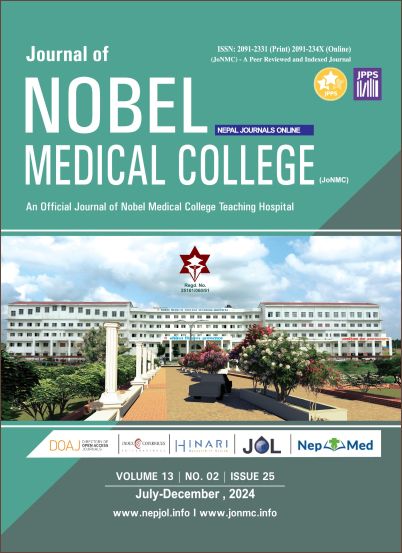An Observational Study of Transesophageal Echocardiography in Patients Presenting with Ischemic Stroke
DOI:
https://doi.org/10.3126/jonmc.v13i2.75097Keywords:
Echocardiography, Ischemic stroke, TransesophagealAbstract
Background: Transesophageal echocardiography is a valuable tool for identifying stroke causes, particularly left atrial clots and cardiac abnormalities undetectable by other methods. However, studies on transesophageal echocardiography in resource-limited settings like Nepal are limited. This study aims to examine the demographics, clinical features, and transesophageal echocardiography findings of ischemic stroke patients.
Materials and Methods: An observational study was done in patients with ischemic stroke undergoing transesophageal echocardiography in a tertiary care center from April 1, 2022 to December 31, 2023. All the patients undergoing transesophageal echocardiography were included in the study after getting the ethical approval from the institutional review board with IRC-KUSMS Approval No. 54/24. Total population sampling was done. Descriptive statistics was used to analyze data.
Results: The mean age of the patients was 57.35±12.36 years. Smoking was seen in 40 (66.67%), hypertension in 37 (61.67%), dyslipidemia in 31 (51.67%), and diabetes mellitus in 30 (50.00%). Other risk factors included contraceptive use in 14 (23.30%) and rheumatic heart disease in 5 (8.30%). Left atrial clots were observed in 9 (15.00%), while left atrial (LA) enlargement (≥40 mm) was found in 57 (95.00%). The study shows that TEE is superior to detecting left atrial clots those missed by Transesophageal echocardiography. Among these, 7 males had a left atrial size <41 mm, and 1 female had a left atrial size <39 mm. There is also significant difference in left atrial size between the different age groups (p=0.001) with older age groups having larger Left Atrial size. Additionally, atrial septal defect was found in 3 (5.00%), patent foramen ovale in 1 (1.67%), and valvular heart disease in 18 (30.00%).
Conclusion: Transesophageal echocardiography detected crucial cardiac abnormalities in ischemic stroke patients, including left atrial thrombi and valvular dysfunction in our study.
Downloads
Downloads
Published
How to Cite
Issue
Section
License
Copyright (c) 2024 The Author(s)

This work is licensed under a Creative Commons Attribution 4.0 International License.
JoNMC applies the Creative Commons Attribution (CC BY) license to works we publish. Under this license, authors retain ownership of the copyright for their content, but they allow anyone to download, reuse, reprint, modify, distribute and/or copy the content as long as the original authors and source are cited.




